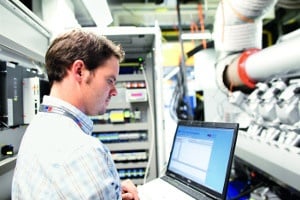Unit Not in Auto
Check that the AUTO/RUN/OFF switch is in the AUTO position for automatic starting or the RUN position for manual starting. If the switch is in the OFF position, investigate why it is set to OFF before switching to AUTO or RUN and attempting to start the unit (i.e., Lock-Out/Tag-Out, maintenance work, etc.)
Weak or Dead Batteries
Weak or dead batteries are the cause of 80% of generator failures to start. Dead or low-charged batteries are a common occurrence and may result from an old battery or a faulty battery charger.
Lead-acid batteries deteriorate over time and require maintenance. Even maintenance-free batteries will lose their effectiveness over time, and all lead-acid batteries have a life expectancy of approximately 4 years. Routine maintenance and testing can help detect a dying battery, and we recommend that batteries be replaced every 3 years.
Battery chargers are also sensitive electronic devices that are subjected to a harsh environment, and therefore are prone to failure. Battery chargers should be checked weekly on systems that involve life safety or critical loads, and at least monthly on other systems.
Fuel Problems
Lack of fuel or poor fuel quality is another common reason that generators fail to start or shut down during operation.
Fuel quality should be checked as part of the routine maintenance plan. Diesel-fueled units may experience water in the system or other contaminants that can clog filters, fuel lines, and injectors. In diesel systems, checking the main and day tanks for water or sending a fuel sample to a lab for analysis periodically will help determine the fuel quality. Poor quality fuel should be replaced with fresh fuel. In some cases, it may be possible to add fuel treatments to help preserve or revitalize the fuel. Diesel fuel cleaning or polishing is another option for ensuring that the engine has clean fuel.
Lack of fuel will affect both diesel and gaseous units and may be due to a lack of storage, leaks, or problems with fuel delivery from suppliers or bulk fuel storage tanks. Confirm that sufficient fuel is available. Check that fuel shutoff valves are open. Check that day tanks and fuel pumps are operating correctly.
For the most part, fuel leaks relate to human error but can be caused by deteriorated fuel lines or tanks or faulty pump equipment.
In newer diesel engines that are not exercised on a regular basis, fuel can bleed back into the tank and the system loses prime. Today's rigorous emissions requirements make high pressure fuel systems more prone to air, impacting the ability for the genset to start up. Older generators that experience this problem may have a leak in a fuel line or check valves that are not properly holding the fuel in the engine.
It is always possible that the fuel level gauges have stopped working properly. The gauge may get stuck in position so it is important to visually inspect or use a measuring stick to check the fuel level periodically.
Engine Cranks But Fails to Start
This indicates a possible fuel system problem. The engine stops cranking or the engine runs and then shuts down.
- Check for empty fuel tank, fuel leaks, or plugged fuel lines and correct as required.
- Check for dirty fuel filter and replace if necessary.
- Check for dirty or plugged air filter and replace if necessary.
- Check the oil level, lines, and filters and correct as necessary.
- Reset the control and restart after correcting the problem.
- Contact us to speak with a technician if none of the above.
Low Engine Temperature
Indicates engine coolant heater is not operating or is not circulating coolant. Check for the following conditions:
- Coolant heater not connected to power supply. Check for blown fuse, open circuit breaker, or disconnected heater cord and correct as required.
- Check for low coolant level and replenish if required. Look for possible coolant leakage points and repair as required.
Engine Will Not Crank
Indicates possible fault with control or starting system. Check for the following conditions:
- Fault lamp on. Correct fault and reset control.
- Poor battery cable connections. Clean the battery cable terminals and tighten all connections.
- Discharged or defective battery. Recharge or replace the battery.
- Contact us to speak with a technician if none of the above.
.png?width=159&height=72&name=Curtis%20Power%20Solutions%20(RGB).png)







